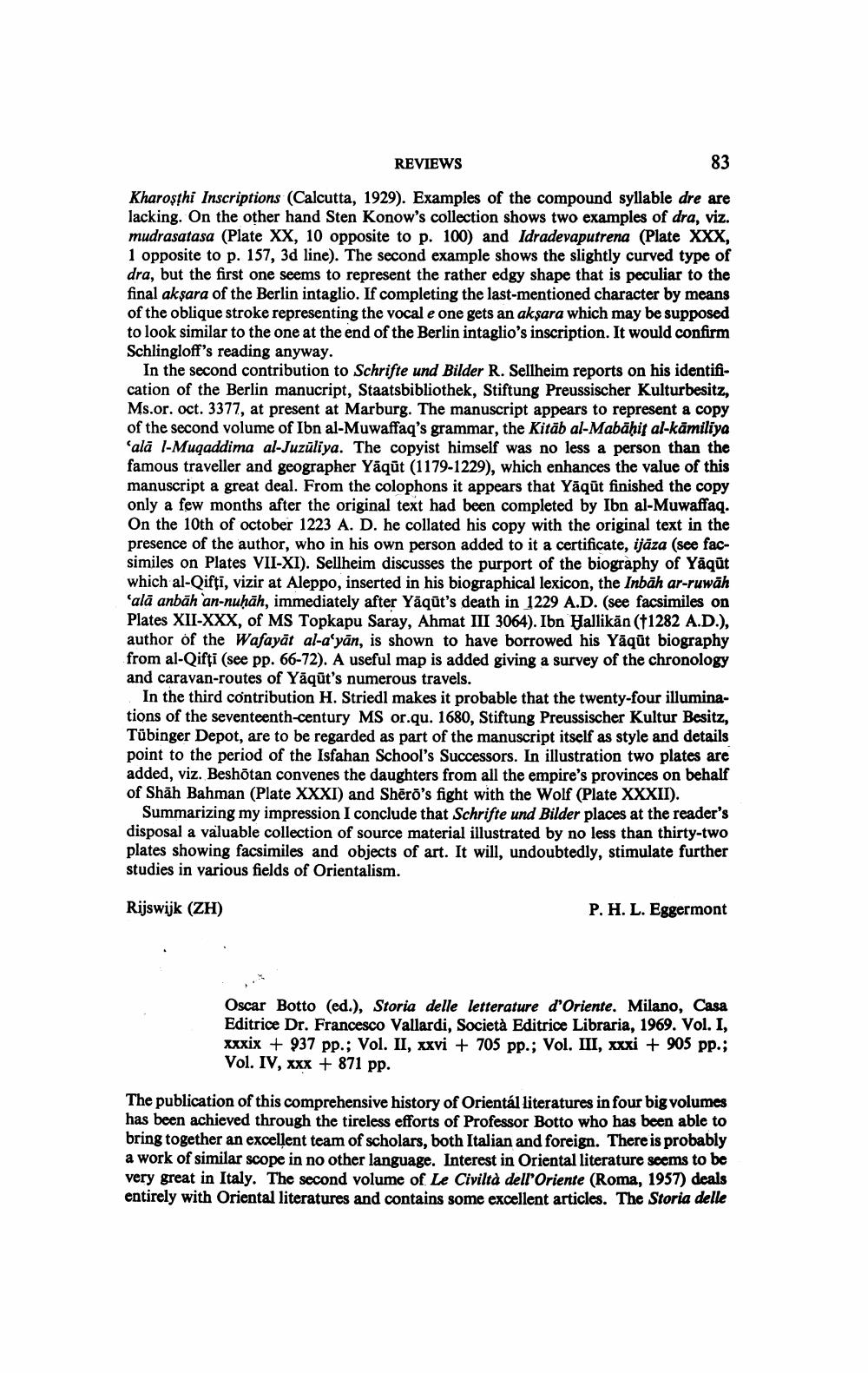Book Title: Reviews Of Different Books Author(s): Publisher: View full book textPage 7
________________ REVIEWS Kharosthi Inscriptions (Calcutta, 1929). Examples of the compound syllable dre are lacking. On the other hand Sten Konow's collection shows two examples of dra, viz. mudrasatasa (Plate XX, 10 opposite to p. 100) and Idradevaputrena (Plate XXX, 1 opposite to p. 157, 3d line). The second example shows the slightly curved type of dra, but the first one seems to represent the rather edgy shape that is peculiar to the final aksara of the Berlin intaglio. If completing the last-mentioned character by means of the oblique stroke representing the vocal e one gets an aksara which may be supposed to look similar to the one at the end of the Berlin intaglio's inscription. It would confirm Schlingloff's reading anyway. In the second contribution to Schrifte und Bilder R. Sellheim reports on his identification of the Berlin manucript, Staatsbibliothek, Stiftung Preussischer Kulturbesitz, Ms.or. oct. 3377, at present at Marburg. The manuscript appears to represent a copy of the second volume of Ibn al-Muwaffaq's grammar, the Kitab al-Mabahit al-kamiliya 'ala l-Muqaddima al-Juzuliya. The copyist himself was no less a person than the famous traveller and geographer Yaqut (1179-1229), which enhances the value of this manuscript a great deal. From the colophons it appears that Yaqut finished the copy only a few months after the original text had been completed by Ibn al-Muwaffaq. On the 10th of october 1223 A. D. he collated his copy with the original text in the presence of the author, who in his own person added to it a certificate, ijaza (see facsimiles on Plates VII-XI). Sellheim discusses the purport of the biography of Yaqut which al-Qifti, vizir at Aleppo, inserted in his biographical lexicon, the Inbah ar-ruwah 'ala anbah an-nuhah, immediately after Yaqut's death in 1229 A.D. (see facsimiles on Plates XII-XXX, of MS Topkapu Saray, Ahmat III 3064). Ibn Hallikan (+1282 A.D.), author of the Wafayat al-a'yan, is shown to have borrowed his Yaqut biography from al-Qifti (see pp. 66-72). A useful map is added giving a survey of the chronology and caravan-routes of Yaqut's numerous travels. In the third contribution H. Striedl makes it probable that the twenty-four illuminations of the seventeenth-century MS or.qu. 1680, Stiftung Preussischer Kultur Besitz, Tubinger Depot, are to be regarded as part of the manuscript itself as style and details point to the period of the Isfahan School's Successors. In illustration two plates are added, viz. Beshotan convenes the daughters from all the empire's provinces on behalf of Shah Bahman (Plate XXXI) and Shero's fight with the Wolf (Plate XXXII). Summarizing my impression I conclude that Schrifte und Bilder places at the reader's disposal a valuable collection of source material illustrated by no less than thirty-two plates showing facsimiles and objects of art. It will, undoubtedly, stimulate further studies in various fields of Orientalism. Rijswijk (ZH) P. H. L. Eggermont Oscar Botto (ed.), Storia delle letterature d'Oriente, Milano, Casa Editrice Dr. Francesco Vallardi, Societa Editrice Libraria, 1969. Vol. I, xxxix + 937 pp.; Vol. II, xxvi + 705 pp.; Vol. III, Xxxi + 905 pp.; Vol. IV, XXX + 871 pp. The publication of this comprehensive history of Oriental literatures in four big volumes has been achieved through the tireless efforts of Professor Botto who has been able to bring together an excellent team of scholars, both Italian and foreign. There is probably a work of similar scope in no other language. Interest in Oriental literature seems to be very great in Italy. The second volume of Le Civilta dell'Oriente (Roma, 1957) deals entirely with Oriental literatures and contains some excellent articles. The Storia dellePage Navigation
1 ... 5 6 7 8 9 10 11 12 13 14 15 16 17 18
